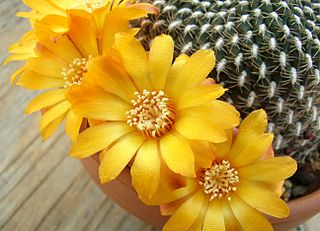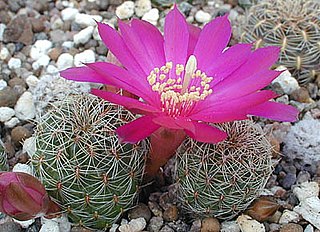
Augustin Pyramusde Candolle was a Swiss botanist. René Louiche Desfontaines launched de Candolle's botanical career by recommending him at a herbarium. Within a couple of years de Candolle had established a new genus, and he went on to document hundreds of plant families and create a new natural plant classification system. Although de Candolle's main focus was botany, he also contributed to related fields such as phytogeography, agronomy, paleontology, medical botany, and economic botany.

Hugo Marie de Vries was a Dutch botanist and one of the first geneticists. He is known chiefly for suggesting the concept of genes, rediscovering the laws of heredity in the 1890s while apparently unaware of Gregor Mendel's work, for introducing the term "mutation", and for developing a mutation theory of evolution.

Rebutia is a genus of flowering plants in the family Cactaceae, native to Bolivia and Argentina. The limits of the genus have varied widely, depending on whether genera such as Aylostera and Weingartia are included or treated separately. As of December 2024, Plants of the World Online accepted only three species of Rebutia. A very large number of plants that have been treated in cultivation as species of Rebutia are now generally regarded as varieties, forms or synonyms of a much smaller number of species, or have been transferred to other genera. Plants treated as Rebutia are generally small, colorful cacti, globular in form, which freely produce flowers that are relatively large in relation to the body. They have no distinctive ribs, but do have regularly arranged small tubercles. They are considered fairly easy to grow and they may produce large quantities of seeds that germinate freely around the parent plant.

Weingartia is a genus in the family Cactaceae, with species native to Bolivia and Argentina. It was formerly included in Rebutia, but molecular phylogenetic evidence suggested that it was distinct from that genus. As of December 2024, it was treated as separate genus by Plants of the World Online, and recognized as an alternative generic name in the third edition of the CITES Cactaceae Checklist. It may also be treated as Rebutia subg. Weingartia.

Zygnematophyceae is a class of green algae in the paraphylum streptophyte algae, also referred to as Charophyta, consisting of more than 4000 described species. The Zygnematophyceae are the sister clade of the Embryophyta.
Angie Passmore is a British puppeteer and actress who has worked on Spitting Image and in various productions for The Jim Henson Company including The Muppets, Fraggle Rock, Labyrinth (1986) and performed as the title character in Jim Henson's Mother Goose Stories. She also puppeteered for Doctor Who (1978) and in the film Little Shop of Horrors (1986) which was directed by Frank Oz.

Weingartia arenacea, the arenaceous crown cactus, is a species of cactus native to central Bolivia. It has been renamed Weingartia arenacea. It has gained the Royal Horticultural Society's Award of Garden Merit.

Weingartia canigueralii is a species of cactus in the genus Weingartia, native to Bolivia. It has gained the Royal Horticultural Society's Award of Garden Merit.
Weingartia alba is a species of flowering plant in the family Cactaceae, native to Bolivia. It was first described by Walter Rausch in 1971 as Sulcorebutia alba.

Weingartia crispata is a species of flowering plant in the family Cactaceae, native to Bolivia. It was first described by Walter Rausch in 1970 as Sulcorebutia crispata.
Weingartia fischeriana is a species of flowering plant in the family Cactaceae, endemic to Bolivia. It was first described by Karl Augustin in 1970 as Sulcorebutia fischeriana.

Weingartia heliosoides is a species of cactus in the genus Weingartia, endemic to Bolivia.

Weingartia vasqueziana is a species of flowering plant in the family Cactaceae, endemic to Bolivia. It was first described by Walter Rausch in 1970 as Sulcorebutia vasqueziana.

Weingartia mentosa, the crown cactus, is a species of cactus in the genus Weingartia, native to Bolivia. It has gained the Royal Horticultural Society's Award of Garden Merit.

Weingartia neocumingii, the Cuming crown cactus, is a species of cactus in the genus Weingartia, endemic to Bolivia. It has gained the Royal Horticultural Society's Award of Garden Merit.

Weingartia steinbachii, called Steinbach's crown cactus, is a species of cactus in the genus Weingartia, native to Bolivia. It has gained the Royal Horticultural Society's Award of Garden Merit.
Weingartia corroana is a species of flowering plant in the family Cactaceae, native to Bolivia. It was first described by Martín Cárdenas in 1951 as Weingartia pulquinensis var. corroana and then raised to a full species in 1964.
Weingartia hediniana is a species of flowering plant in the family Cactaceae, native to Bolivia. It was first described by Curt Backeberg in 1950.
Weingartia mizquensis is a species of flowering plant in the family Cactaceae, endemic to Bolivia. It was first described by Walter Rausch in 1970 as Sulcorebutia mizquensis.
Weingartia taratensis is a species of flowering plant in the family Cactaceae, native to Bolivia. It was first described by Martín Cárdenas in 1964 as Rebutia taratensis.












